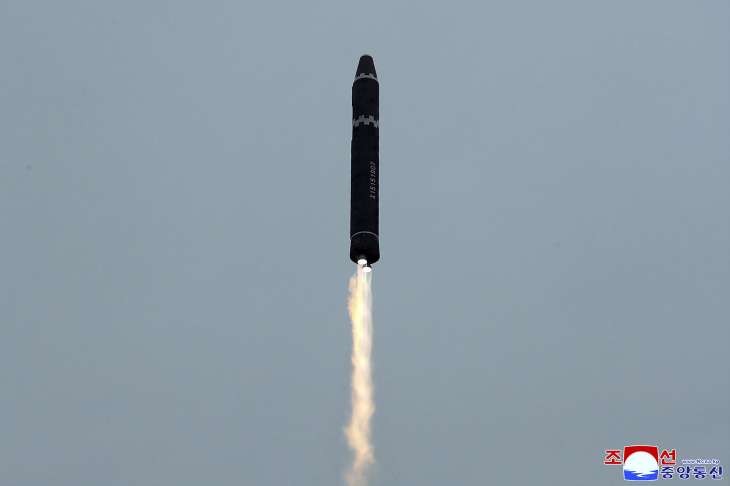
North Korea on Monday fired two short-range ballistic missiles towards its eastern waters. It was the second missile test in three days, reigniting regional hostilities over US-South Korean military drills. North Korea described the joint military exercise as a rehearsal for the invasion.
Strong reaction to US-S Korean military drills
An intercontinental ballistic missile launch on Saturday was followed by the firing of short-range ballistic missiles and North Korea threatened an unprecedented tough response to the drills.
A new spree of testing allows North Korea to expand its arsenal amid stalled talks with its rivals and eventually use the increased military capability as leverage to try to extract major concessions from the United States Does
South Korea’s response
South Korea’s Joint Chiefs of Staff said in a statement that South Korea detected two missile launches from a western coastal city just north of North Korea’s capital, Pyongyang. It said South Korea has increased its surveillance posture and maintains readiness in close coordination with the United States.
Japan’s response
Japan’s Defense Ministry said both missiles landed in the waters between the Korean Peninsula and Japan. It said Japan condemned the launch as a threat to the peace and security of Japan and to international society.
The Japanese Defense Ministry said the first missile reached a maximum altitude of 100 kilometers (62 mi) and flew for 400 kilometers (250 mi).
It said the second missile reached an altitude of about 50 kilometers (30 mi) and traveled a distance of 350 kilometers (217 mi).
North Korea’s state media said long-range artillery units on its west coast fired two rounds cross-country towards eastern waters on Monday morning, possibly referring to the same activity its neighbors said were missile launches.
The official Korean Central News Agency said the North Korean artillery rounds simulated strikes on targets up to 395 kilometers (245 miles) away.
The North said the launch included its new 600-millimetre multiple rocket launcher system that could be equipped with “tactical” nuclear weapons for use on the battlefield. Some experts see the weapon system as a short-range ballistic missile.
“The frequency of using the Pacific as our firing range depends on the action character of the US military,” Kim Yo Jong, the powerful sister of North Korean leader Kim Jong Un, said in a statement carried by state media. “We are well aware of the movement of US military strategic strike means around the Korean Peninsula has been intensifying recently.”
Calling the United States “the worst lunatic”, he threatened to take an unspecified “corresponding response” in response to future moves by the US military.
She may be referring to US flyovers of B-1B long-range supersonic bombers on Sunday for separate training with South Korea and Japan. The B-1B deployment came as a response to North Korea’s launch of the Hwasong-15 ICBM off its east coast on Saturday in the country’s first missile test since January 1.
North Korea is highly sensitive to the deployment of B-1B bombers, which can carry heavy payloads of conventional weapons.
North Korea’s state media said on Sunday that the ICBM test was to further enhance its “deadly” nuclear strike capability and to verify the weapon’s reliability and the combat readiness of the country’s nuclear force. In an earlier statement on Sunday, Kim Yo Jong threatened to take extra-powerful steps over upcoming military drills between the US and South Korea.
North Korea has regularly slammed South Korea-US military drills as a prelude to aggression toward the North, although allies say their drills are defensive in nature. Some observers say that North Korea often uses its rivals’ exercises as an excuse to try and improve its weapons systems.
South Korean and US The military plans to hold a table-top exercise this week to step up a joint response to the possible use of nuclear weapons by North Korea.
The allies are also scheduled to conduct another joint computer simulated exercise and field training in March.
North Korea boasts missiles capable of striking both the US mainland and South Korea with nuclear warheads, but many foreign experts have said North Korea still has some key technologies to master. Such as miniaturizing the warheads that can be mounted on missiles and ensuring that those warheads survive atmospheric re-entry.
In his statement on Monday, Kim Yo Jong reiterated that North Korea has reentry vehicle technology. He also hit back at South Korean experts who questioned whether North Korea’s ICBMs would be functional in real combat conditions.
Kim Yo Jong stressed that the nine-hour launch preparation time following orders from her brother Kim Jong Un included efforts to seal the launch site and evacuate people, and that it did not take longer due to deficiencies in the missile system. Was.
Last year, North Korea set an annual record with more than 70 missile launches. North Korea has said that several of those weapons tests were a warning over previous US-South Korean military exercises. It also passed a law that allows it to preemptively use nuclear weapons in a wide range of scenarios.
Kim Jong Un entered 2023 with calls for an “exponential increase” of the country’s nuclear arsenal, mass production of battlefield tactical nuclear weapons targeting South Korea and development of more advanced ICBMs targeting the US.
(with AP input)